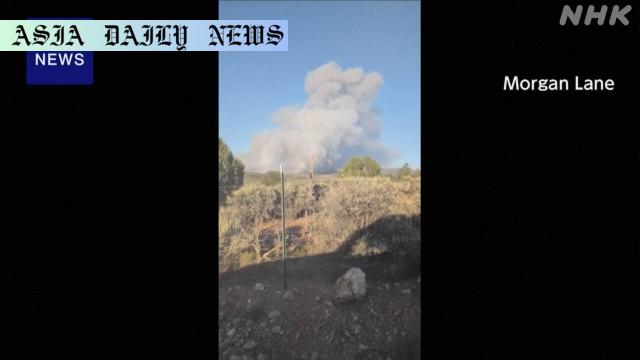Wildfire sparks massive damage at Grand Canyon National Park, closing North Rim for the rest of the season.

Wildfire Sparks Massive Destruction in Grand Canyon National Park
A rapidly spreading wildfire in the iconic Grand Canyon National Park, located in Arizona, has wreaked havoc, forcing the closure of its North Rim for the rest of the season, which typically ends in mid-October. The fire, which began on July 4 due to a lightning strike, has spread alarmingly, burning over 30 square kilometers of natural land.
The fire has destroyed more than 70 structures, including a historic lodge and a series of visitor cabins that play a key role in the park’s tourism experience. These losses signify a major blow not only to the heritage of the area but also to the local economy that thrives on the National Park’s substantial influx of visitors each year. Despite the extensive damage, no injuries have been reported, which is a small but significant relief amidst the devastation caused by this natural disaster.
Closure of North Rim and Ongoing Safety Measures
The US National Park Service has announced that the North Rim will be closed to visitors for the rest of the season, emphasizing safety concerns. With fire containment still underway, the decision likely aims to safeguard visitors and park staff from further danger. The closure underscores the critical need for prevention and intervention strategies to prepare for such natural disasters, particularly in regions prone to wildfires.
As park officials and firefighters continue to monitor and mitigate the situation, visitors are urged to stay informed and heed all safety guidelines if planning a trip to the region. For many enthusiasts and travelers, the closure serves as a stark reminder of the unpredictable power of nature and the importance of protecting such unique natural treasures.
Controversy Over Controlled Fire Management
The wildfire has also ignited controversy regarding its management by federal authorities. Arizona Governor Katie Hobbs has raised concerns over the federal government’s decision to manage the fire as a controlled burn despite the extremely hot and dry weather conditions prevalent at the time. In her statement, she insisted on a “comprehensive, thorough, and independent investigation,” urging federal authorities to reassess their protocols for handling such threats in similar climates.
Her call implies a need for accountability and transparency in wildfire management strategies, especially as climate change continues to exacerbate the frequency and intensity of such catastrophes. While controlled burns are a recognized method for reducing fuel buildup and preventing larger fires, the risks involved in such operations during unfavorable weather conditions cannot be ignored.
Impacts on Arizona’s Tourism and Local Communities
The destruction of key structures like the historic lodge and cabins not only disrupts visitor plans but also directly impacts the livelihoods of local businesses and communities reliant on the park’s tourism. The Grand Canyon’s North Rim holds unique charm and attracts thousands of visitors each year, making its closure and the significant losses a profound contributor to regional economic strain.
Mitigating future risks and ensuring the park’s recovery will likely require concerted efforts by state, federal, and local institutions. In the long term, greater investments in robust fire-prevention strategies and infrastructure could help protect invaluable cultural and natural resources in regions like this.
The Need for Proactive Climate Adaptation Strategies
The Grand Canyon wildfire underscores the importance of comprehensive risk management strategies in a time when climate change is contributing to hotter, drier conditions. Proactive measures such as responsive fire management, climate adaptation action plans, and enhanced emergency response systems could minimize the potential for such tragedies.
Let this incident serve as a crucial reminder of the continuous need for balancing human activities, conservation goals, and state-of-the-art safety protocols to safeguard one of America’s most iconic natural landmarks.
Commentary
Understanding the Challenges Behind Managing Wildfires
The recent wildfire at the Grand Canyon National Park highlights the persistent challenges associated with managing natural disasters. As a lightning strike turned into a rapidly spreading blaze, the devastation it left behind reminds us of nature’s unpredictability and power. However, the situation also points to potential lapses or miscalculations that might have been avoided, especially considering Arizona’s hot and dry summer climate known to exacerbate fire risks.
The Debate on Controlled Burns
The decision to manage this fire as a controlled burn has initiated critical conversations among policymakers, scientists, and locals. While controlled burns are often employed as a prevention tool, executing them during high-risk weather conditions seems counterintuitive. Such decisions amplify not only the risks to local ecosystems and structures but also erode public trust in fire management strategies. Governor Katie Hobbs’ call for an in-depth investigation into management decisions is justified, as it could set the precedent for how such situations are approached in the future.
Long-term Impacts and Lessons to Learn
Beyond the immediate damage to over 70 structures and the closure of the North Rim, this wildfire has broader implications. Communities that rely heavily on tourism from the Grand Canyon are now faced with economic uncertainty, while the historic value of destroyed structures is irreplaceable. These losses underscore the urgency of bolstering wildfire prevention efforts and seamlessly integrating climate-resilience mechanisms.
In the future, authorities and communities must work collaboratively to create a balance between preservation, safety, and sustainable visitor experiences. Through transparent discussions and stronger preventive frameworks, it is possible to learn from this tragedy and build a future focused on both conservation and protection.


